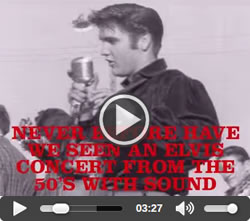Elvis Presley : Rising Sun and other Horses at Graceland
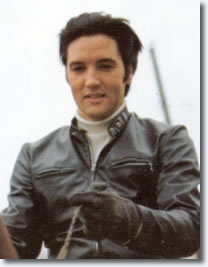 Jerry remembers horse shopping with Elvis. Though he didn't know anything about horses, Jerry got to be the test pilot. Finally, after a lot of laughing and looking, a four-year-old, black, Quarter Horse named Domino was purchased for Priscilla, and a light cream-colored horse, named Sheba, for Sandy.
Jerry remembers horse shopping with Elvis. Though he didn't know anything about horses, Jerry got to be the test pilot. Finally, after a lot of laughing and looking, a four-year-old, black, Quarter Horse named Domino was purchased for Priscilla, and a light cream-colored horse, named Sheba, for Sandy.
Priscilla turned out to be a natural, graceful rider and often rode around the grounds bareback.

Soon Elvis was on a quest for a horse of his own, but finding just the right horse wasn't easy. The first horse he bought was gentle, and helped Elvis regain his confidence, but he soon got bored with it.
In the documentary Elvis, By the Presleys, Priscilla Presley recalls those days, 'He wanted a golden palomino. He would get up at 3:00 in the morning; go to certain farms and ranches and say, 'Do you have a Golden Palomino for sale?' People would say, 'that was Elvis Presley'.
As word of their horse buying got out, Jerry was approached by Robert Boyd about a horse he had for sale, a big, beautiful, palomino Quarter Horse, ridden and shown at the time by Boyd's 12-year-old daughter. Elvis bought the horse on the spot. Renamed Rising Sun, the horse became Elvis' personal mount, and the horse barn soon bore the name House of the Rising Sun.
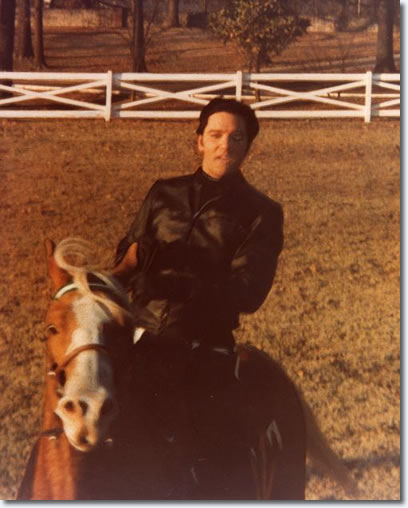
Elvis Presley at Graceland riding Rising Sun.
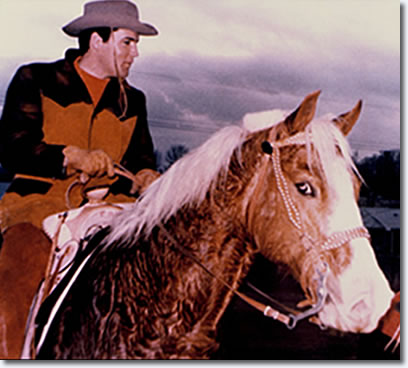
Elvis Presley at his Circle G Ranch, Mississippi riding Rising Sun.
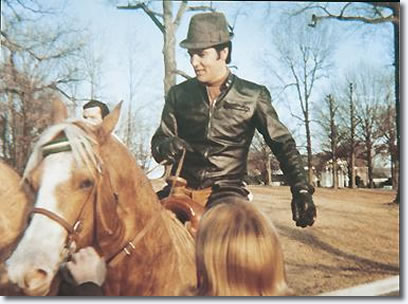
Elvis Presley at Graceland riding Rising Sun.
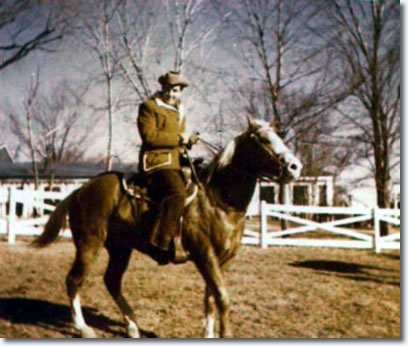
Elvis Presley at Graceland riding Rising Sun.
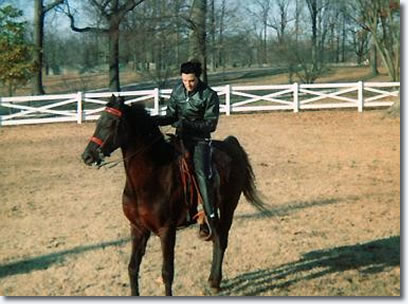
Elvis rode hard, but cared deeply for his horses -- Told he should walk Rising Sun to cool him down, he did so – three times as long as would ha ve been necessary.
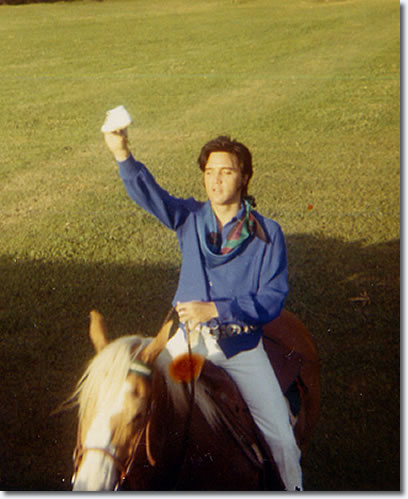
Elvis on Rising Sun at Graceland, circa May-June 1969.
Elvis bought more horses - and then trucks and trailers - for his friends and bodyguards. Priscilla remembers playfully, 'It didn't matter if you wanted one or not, you were getting a horse!' Jerry was the official test rider for each one, finally claiming a big, friendly black horse with a white spot on his face as his own.
Jerry remembers that time at Graceland fondly. 'It was a romantic time', he says. 'Elvis and I both got married that spring. It was really great if you want quality time to spend with a friend … to be walking the horses at the end of the day, fixing up the barn. It was cold; we had a little campfire. A very, very special time'.
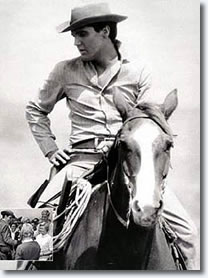 |
|---|
| Elvis in the movie 'Flaming Star'. |
But the herd outgrew the grounds at Graceland and in February of 1967 Elvis purchased a 163-acre cattle ranch just across the state line in Mississippi, which he had spotted on a rare, daylight drive. The ranch was named the Circle-G, in honor of Graceland. House trailers were set up at the ranch for friends and family, but Priscilla cherished the small ranch house, as it was her first real chance to live alone with Elvis.
Like so many of us, Elvis sought solace in his land and his horses. Priscilla recalls, 'In the morning right after breakfast he was out riding'. At this point, he was frustrated with his acting career, as his movies were more designed to cash in on his fame and singing - rather than his acting talent. Is it a coincidence that some of his best movies were those with horses?
Other horses brought to Graceland or the Circle G included Colonel Midnight, a black Tennessee Walking Horse bought for Elvis' father, Vernon. The horse belonged to Ruth Spence, who did not want to part with him, but Elvis made an offer her husband couldn't refuse and the horse was sold.
He was renamed in honor of Colonel Tom Parker, Elvis' manager.
A favorite was Bear, a fully trained, flat-shod, Tennessee Walking Horse. Another, favored for her speed over her looks, was a grade mare, Elvis named Mare Ingram in honor of Memphis Mayor William B. Ingram. The Mayor was slow to have something in Memphis named after Elvis, eventually renaming a portion of U.S. Hwy 51 (that runs past Graceland) Elvis Presley Boulevard, but not before Elvis had named the mare in his 'honor'.
Other horses were Beauty ; Big Red (bought for Red West, Elvis' bodyguard and friend); Buckshot (named after Wild Bill Hitchcock's horse); El Poco ; Flaming Star ; Golden Sun ; Lady ; Moriah (Lisa Marie's pony); Memphis (Tennessee Walking Horse); Scout ; Star Trek ; Sundown ; Thundercloud and Traveler (who had belonged to Mary Travers, of Peter, Paul and Mary).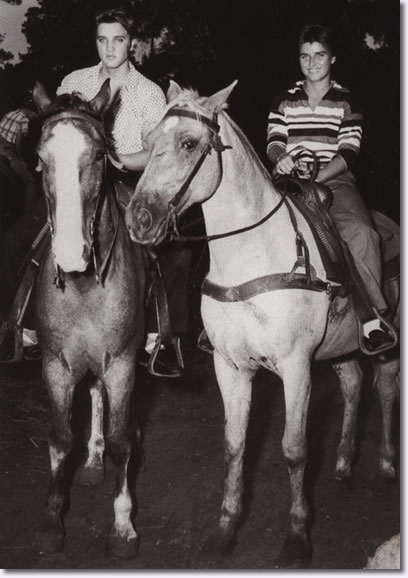
June Juanico & Elvis Presley Gulf Hills Dude Ranch 1956.
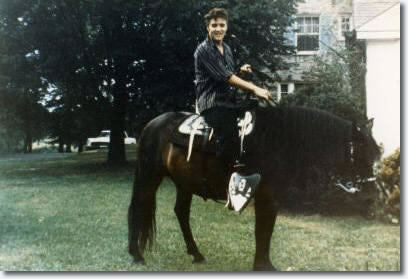
Elvis at Graceland 1950s.
Jerry shares how Elvis felt about Tennessee Walking Horses.
'He loved the way they moved, that whole gait. He just thought it was quite beautiful. In my home movies there is a shot of him on Colonel Midnight, riding along a white board fence. He just thought it was a marvelous thing to watch and ride a Tennessee Walking Horse'.
Elvis got into horses like he got into everything; he eased into it right over the top. In Me and A Guy Named Elvis Jerry tells how the interest escalated to excess – in typical Elvis fashion. 'Elvis being Elvis, almost every day we were taking another trip somewhere to buy another horse', he says. Elvis spent nearly a million dollars in just a few weeks'. Movie roles and home videos reveal an extremely confident rider with the balance, seat and hands that only time in the saddle can produce.
A conscientious horseman,
After a hard ride, Elvis would walk his horse three times longer than necessary to cool him out, just to be sure the horse was safe to return to pasture. He was fastidious about the barn area, and personally marked each person's tack hook and stall … Daddy's, Priscilla's, Mine… The labels remain in the barn to this day.
Sometimes Elvis would ride down to the gates of Graceland and show off for his fans, sit and chat from the saddle, and sign autographs. Then to their gasping admiration, he'd take off on Rising Sun at a dead gallop back towards the barn. Elvis was so attached to Bear, a Tennessee Walking Horse, that when the horse died while Elvis was on tour, no one would tell him until he got home, fearing how the news would devastate him.
The horses were a great escape, though unlike most horsemen, Elvis and his friends were denied the simple freedom of trail riding off the ranch. 'We never went anywhere in public; we couldn't', Jerry says. 'Even to go to the movies we had to wait til midnight and then rent the entire theater'. Like every other aspect of 'Elvis time' horseback riding often happened at odd hours.
But the bloom of ranching faded.
Equipment was auctioned off at the Circle G on November 4, 1967, and the sale of the ranch soon followed.
Some of the horses returned to Graceland.
Not long after, Elvis quit making movies entirely, and went back to live singing performances. Years later, he was at home, between tours, when the world was stunned by the news of his death.
Long Live the King
On August 16, 1977, Elvis died at Graceland. His father, grandmother and other family members remained, but the grieving family paid little attention to the horses. Because the $350,000 estate cost nearly $500,000 a year to maintain, Priscilla Presley decided to open her former home to the public to pay the bills. One of the many hopefuls who applied for a job as a tour guide was Alene Alexander, who in 1978 (as Alene Raiford) had won the WGC Pleasure Racking Horse title on the lovely sorrel mare, MISS GO GIRL.
As she toured the grounds, a startling sight caught her attention. There, in the nearly barren pasture, were five horses, Alene describes as 'in very poor shape'. Alene set Graceland on its heels on behalf of those horses.
She explains, 'The horses were on their own. Elvis took such good care of them, but when he died, the heart of Graceland died'. The staff apologized, saying they thought that the horses were just old. In time, Alene, with unlimited support from Graceland, got them back into beautiful condition.
On June 7, 1982 public tours Began
'By 1984 Rising Sun was looking great', Alene beams. 'Priscilla was very appreciative, and wrote letters. She is a real animal lover'. Aside from feeding and health care issues, another surprise awaited the new head of Graceland's stables. Elvis' habit of racing back to the barn had left the horses exceedingly barn sour.
Royalty Revealed
The last horse that elvis had brought to Graceland, was Ebony's Double, purchased in 1975 as a two-year-old from the George Lennox farm, home of the legendary Carbon Copy.
The story goes that Elvis was taken with the sleek black colt, who, when Elvis first saw him was decked out in red leg wraps in striking contrast to his gleaming jet black coat. Some Walking Horse folks touring the grounds in 1983 inquired about 'that big, black horse'. When they realized the gelding was a son of the 1962 WGC Ebony Masterpiece, they pressed Graceland to consider showing him in a special retirement ceremony at the Tennessee Walking Horse World Celebration that September. Graceland officials deferred the decision to Priscilla and met with her, thinking she would ride the horse in the ceremony.
'He hadn't been ridden since Elvis died', recalls Alene. Just in case Priscilla accepted the honor, a horse trailer was in waiting during the meeting, discretely parked down the street.
She did accept, but with a twist. 'I want Alene to ride the horse', Priscilla said.
Alene was really the only person in the group that could have pulled it off, and the reality of the situation was something she fully appreciated. Here was a horse brought back from neglect, a pasture ornament for years, out of shape and with barely a hint of a memory of what to do under saddle. Why not have him ready for a formal ceremony at one of the world's biggest horse shows in eight weeks time?
Alene recalls the intense preparation for the Celebration. 'In six weeks', she said, 'He does nothing. No sign of knowing what he's to do. Two weeks from the show he hits a lick, but his tendons are sore. Tendonitis'.
The weight of this exhibition had to have weighed on Alene, knowing that this wasn't just any horse show, and this certainly was not just anyone's horse. She believed it was something that would have made Elvis proud. A week before the Celebration, Ebony was stabled in Carbon Copy's own luxurious stall. He had been fitted with a tail set, but reared in the stall, removing it. Alene and trainer, Howard Hamilton, began to strategize - more as a way to minimize embarrassment than to impress the crowed of 40,000.
The plan was to work him just one way of the ring, as they feared he would limp (from the still-touchy tendons) if he worked the other direction. Get in, get out.
And then it was show time.
The lights went down and a single spotlight shone on the big, black horse and his lady rider.
'I gave him just a touch', Alene remembers, 'and his head went up and he hit a lick as though he knew just what to do'. The exhibition of gait exceeded everyone's expectations. Then Alene lined Ebony up facing the crowd. 'They brought out a retirement blanket with white silk roses and the outline of a guitar', Alene continues. 'Priscilla was there. She gave me a kiss on the cheek'. Then it was time to exit the arena.
'I led him out', Alene concludes, 'which we had never rehearsed, and we walked out the gate at the very last note of the music'. At precisely that moment, Ebony did a quick little whirl to the thrilled reaction of the crowd. 'The opportunity to show that horse was a turning point in my life', says Alene.
No Heaven Without Horses
To keep the spirit of Graceland alive as it was in elvis ' time, there will always be horses.
Ebony's Secret Threat (half brother to Ebony's Double ) was the 1983 WGC weanling at the Tennessee Walking Horse Celebration. Priscilla purchased him, but he was ridden too early, and in Alene's words, has since been 'very beautiful yard art'. Rising Sun survived until 1986 and was buried, facing east, into the rising sun. At his death, a nation-wide search was carried on by Elvis Presley Enterprises for a related horse of that same golden palomino color. They found Sun's Reflection, a distant relative. When Lisa Marie's pony, Moriah, suffered a broken leg, she was taken to the veterinary hospital at Mississippi State University and, her leg pinned, survived the incident. She later passed away near the age of 30, of unrelated causes.
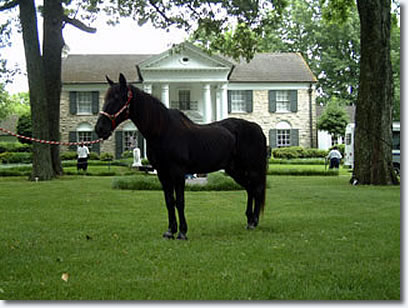
Ebony's Double - The last horse Elvis bought to Graceland.
Ebony's Double died a month shy of his 32nd birthday, January 14, 2005. Mare Ingram, Alene reports, lived to the age of 50. 'We take very good care of these horses', she adds.
Living legacies to Elvis' love of horses remaining at Graceland, include, Just Candy No Cash, (Candy) purchased by trainer Howard Hamilton when Ebony died; Sun's Reflection and Ebony's Secret Threat.
Alene Alexander is still there, too, loving her job. She cherishes her time spent at the barn, sweeping and cleaning. 'When you get home you feel so good', she says. Occasionally, Priscilla or Lisa Marie comes around. 'Lisa has written a note or two, with little hearts around it', Alene says. 'We save those'. The horses receive excellent care under Alene's supervision, with daily grooming and on-call veterinarians. Her love of the horses is obvious. She says, 'Come to Graceland, and see that we, too, love the Tennessee Walking Horse'.
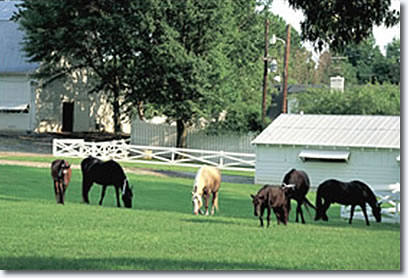
Horses grazing the pasture at Graceland.
Above, Horses grazing the pasture at Graceland. From left: Mare Ingram, Ebony's Double, Rising Sun, Moriah, Memphis, and Ebony's Secret Threat, the only one of these horses still alive at Graceland.
![]() Home videos of Elvis at Graceland (Including riding horses)
Home videos of Elvis at Graceland (Including riding horses)
![]() Ebony's Double: Last Horse Elvis Brought To Graceland
Ebony's Double: Last Horse Elvis Brought To Graceland
![]() Rescued horses go to Graceland (2008)
Rescued horses go to Graceland (2008)
![]() Ebony's Double, Last of EP's Horses, Dies at Age 32
Ebony's Double, Last of EP's Horses, Dies at Age 32
![]() Graceland Stable Opens for Tours, Priscilla Presley to Give First Tour
Graceland Stable Opens for Tours, Priscilla Presley to Give First Tour
© Copyright 2024 by www.elvis.com.au & www.elvispresley.com.au
![]() https://www.elvis.com.au/presley/elvis-presley-rising-sun-and-other-horses-at-graceland.shtml
https://www.elvis.com.au/presley/elvis-presley-rising-sun-and-other-horses-at-graceland.shtml
No part of any article on this site may be re-printed for public display without permission.
 Tupelo's Own Elvis Presley DVD
Tupelo's Own Elvis Presley DVD
Never before have we seen an Elvis Presley concert from the 1950's with sound. Until Now! The DVD Contains recently discovered unreleased film of Elvis performing 6 songs, including Heartbreak Hotel and Don't Be Cruel, live in Tupelo Mississippi 1956. Included we see a live performance of the elusive Long Tall Sally seen here for the first time ever. + Plus Bonus DVD Audio.
This is an excellent release no fan should be without it.
The 'parade' footage is good to see as it puts you in the right context with color and b&w footage. The interviews of Elvis' Parents are well worth hearing too. The afternoon show footage is wonderful and electrifying : Here is Elvis in his prime rocking and rolling in front of 11.000 people. Highly recommended.
Tupelo's Own Elvis Presley DVD Video with Sound.




